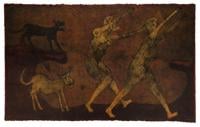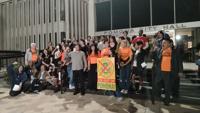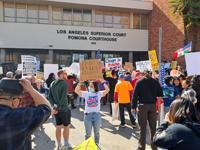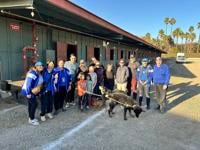
Rufino Tamayo, Two Personages Attacked by Dogs (Dos personajes atacados por perros), 1983, Mixografía print on handmade paper, 60 3/4 × 99 in., Los Angeles County Museum of Art, the Bernard and Edith Lewin Collection of Mexican Art, 2024 Tamayo Heirs/Mexico/Licensed by VAGA at Artists Rights Society (ARS), NY, photo, Museum Associates/LACMA. (LACMA - The Los Angeles County Museum of Art)
Located in Pomona, California at the L.A. County Fair, the Los Angeles County Museum of Art’s (LACMA) exhibition, “Rufino Tamayo: Innovation and Experimentation,” will be on display until the end of the festivities on May 27th.
Originally an exhibition for LACMA’s gallery at the Charles White Elementary School in late 2019 that closed soon after due to the Covid-19 pandemic, “Rufino Tamayo: Innovation and Experimentation” has been revisited through the museum’s partnership with the L.A. County Fair. The partnership is centered around bringing LACMA’s collections to not only the fairgoers who may not see their art collections otherwise but across all of L.A. County.
The exhibition, which spans over 60 years in the prolific career of Rufino del Carmen Arellanes Tamayo (1899-1991), a leading Mexican artist of the 20th century, includes 20 pieces, such as “Hands on Blue Background (Manos sobre fondo azul)” (1979) and “The Personage (El personaje)” (1975), all drawn from LACMA’s collection and focused on the artist’s lifelong passion for prints.
“As a prolific printmaker, [Tamayo] was interested in exploring the possibilities of printmaking and finding ways to add texture and volume to prints that are traditionally two-dimensional on flat paper,” Rachel Kaplan, the associate curator of Latin American art at LACMA, told CALÓ News.

Rufino Tamayo drawing on the lithographic stone for Two Personages Attacked by Dogs (Dos personajes atacados por perros) at the Taller de Gráfica Mexicana, 1982 (print published in 1983), photo: Shaye Remba, courtesy of Mixografia.
Born in Oaxaca de Juárez, Mexico in 1899, Tamayo’s education and art career began when he moved to Mexico City to live with his aunt when he was a child. After taking drawing lessons in 1915, the artist chose to leave school and commit himself fully to art two years later. In 1921, Tamayo was made the head of the Department of Ethnographic Drawing at the National Museum of Archaeology, History and Ethnography in Mexico City.
Throughout his career, Tamayo created murals for the Escuela Nacional de Música in Mexico City and the UNESCO Building in Paris, France and also taught at the Dalton School in New York for nine years. However, a major contribution Tamayo made to the art world was his hand in creating a form of printmaking called Mixografia.
In 1973, when Luis Remba, the owner of the fine art lithography studio Taller de Gráfica Mexicana in Mexico City, approached Tamayo for a collaboration, the printmaker agreed but had one condition; that they would play with techniques to create a more textured surface. The studio published over 80 pieces with Tamayo, such as the 1983 paper mural “Dos Personajes Atacados Por Perros.”

Rufino Tamayo, Trembling Woman (Mujer temblorosa), 1974, lithograph, 29 1/2 × 21 1/4 in., Los Angeles County Museum of Art, the Bernard and Edith Lewin Collection of Mexican Art, 2024 Tamayo Heirs/Mexico/Licensed by VAGA at Artists Rights Society (ARS), NY, photo. Museum Associates/LACMA (LACMA - The Los Angeles County Museum of Art)
“That's where [Tamayo] was able to explore and find ways to add increased volume and texture to prints,” Kaplan said. “Later, the Rembas moved to Los Angeles and now their gallery and workshop is known as Mixografia. In the process of planning the exhibition and researching it, it was a real opportunity to learn from them.”
Along with Diego Rivera, José Clemente Orozco and David Alfaro Siqueiros, Tamayo was considered among the greatest muralists of the time. But, unlike his contemporaries, he did not agree with making a political agenda evident in his art. While he was interested in creating art that was universally understood, as a man of both Mexican and Zapotec descent, Tamayo embraced his heritage through his art and wanted his work to feel inherently Mexican. His efforts and lasting effects on today’s generation of artists can be seen today at the Museo Tamayo, a museum for modern and contemporary international artists in Mexico City, which was founded by Tamayo.
In addition to the several prints, there are also five Mesoamerican objects on display in the exhibition, which was an important source of pride and inspiration for Tamayo. An avid collector of Mesoamerican art, the printmaker established the Museo de Arte Prehispánico de México Rufino Tamayo in Oaxaca to display them. Highlighting this aspect of Tamayo’s career was not the only hope for Kaplan, who wanted to give viewers an expansive look at his life’s work through just a handful of his pieces among the 350 that exist.

Rufino Tamayo, Transparent Man (Hombre transparente), 1964, lithograph, 26 3/8 × 18 7/8 in., Los Angeles County Museum of Art, the Bernard and Edith Lewin Collection of Mexican Art, 2024 Tamayo Heirs/Mexico/Licensed by VAGA at Artists Rights Society (ARS), NY, photo. (LACMA - The Los Angeles County Museum of Art)
“The earliest works in the show are woodcuts from the 1920s and the latest are some of his Mixografía prints from the 1980s,” Kaplan said. “There are also etchings, lithographs and combinations of the techniques. I wanted to make sure that the selected work showed his range.”
An underlying thread throughout this exhibition of vivid color and large-scale paintings is Tamayo’s interest in depicting the human figure, which, throughout the years, became progressively more abstract in his work, but never unrecognizable. “He was interested in finding the essential elements or the basic shapes that he could use in his prints and still have them be recognizable as the human figure,” Kaplan told CALÓ News.
As the exhibition’s curator and an admirer of Tamayo’s art, Kaplan hopes that visitors unfamiliar with the artist’s work will want to learn more and, for those already acquainted with his paintings and murals, that they can expand their knowledge of his career.
“I hope that people will be able to build their own connections with the artworks, whether it's the work by Tamayo or the Mesoamerican objects,” Kaplan said. “Also, if they haven’t been to LACMA before, maybe it will help inspire a future visit.”

Rufino Tamayo, Hands on Blue Background (Manos sobre fondo azul), 1979, etching, 21 3/4 × 30 in., Los Angeles County Museum of Art, the Bernard and Edith Lewin Collection of Mexican Art, 2024 Tamayo Heirs/Mexico/Licensed by VAGA at Artists Rights Society (ARS), NY, photo. Museum Associates/LACMA. (LACMA - The Los Angeles County Museum of Art)
The highlighting of the Mexican artist’s work and spirit doesn’t end there. At the L.A. County Fair, on Fridays from 9 A.M. to 1:30 P.M. and Saturdays from 11 A.M. to 3:30 P.M., all ages can engage their inner artist by creating artwork that is inspired by Tamayo and the exhibition, an activity organized by LACMA’s Education Department.
The “Rufino Tamayo: Innovation and Experimentation” is free with L.A. County Fair admission and is located at the Millard Sheets Art Center 1101 W. McKinley Ave. Pomona, CA 91768.



















(0) comments
Welcome to the discussion.
Log In
Keep it Clean. Please avoid obscene, vulgar, lewd, racist or sexually-oriented language.
PLEASE TURN OFF YOUR CAPS LOCK.
Don't Threaten. Threats of harming another person will not be tolerated.
Be Truthful. Don't knowingly lie about anyone or anything.
Be Nice. No racism, sexism or any sort of -ism that is degrading to another person.
Be Proactive. Use the 'Report' link on each comment to let us know of abusive posts.
Share with Us. We'd love to hear eyewitness accounts, the history behind an article.